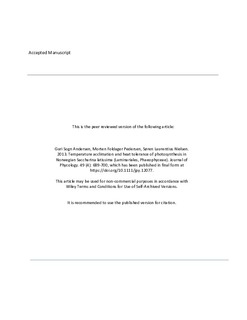| dc.description.abstract | Kelps, seaweeds and seagrasses provide important ecosystem services in coastal areas, and loss of these macrophytes is a global concern. Recent surveys have documented severe declines in populations of the dominant kelp species, Saccharina latissima, along the south coast of Norway. S. latissima is a cold‐temperate species, and increasing seawater temperature has been suggested as one of the major causes of the decline. Several studies have shown that S. latissima can acclimate to a wide range of temperatures. However, local adaptations may render the extrapolation of existing results inappropriate. We investigated the potential for thermal acclimation and heat tolerance in S. latissima collected from three locations along the south coast of Norway. Plants were kept in laboratory cultures at three different growth temperatures (10, 15, and 20°C) for 4–6 weeks, after which their photosynthetic performance, fluorescence parameters, and pigment concentrations were measured. S. latissima obtained almost identical photosynthetic characteristics when grown at 10 and 15°C, indicating thermal acclimation at these temperatures. In contrast, plants grown at 20°C suffered substantial tissue deterioration, and showed reduced net photosynthetic capacity caused by a combination of elevated respiration and reduced gross photosynthesis due to lowered pigment concentrations, altered pigment composition, and reduced functionality of Photo‐system II. Our results support the hypothesis that extraordinarily high temperatures, as observed in 1997, 2002, and 2006, may have initiated the declines in S. latissima populations along the south coast of Norway. However, observations of high mortality in years with low summer temperatures suggest that reduced population resilience or other factors may have contributed to the losses. | nb_NO |
